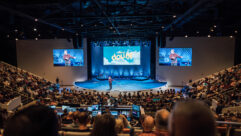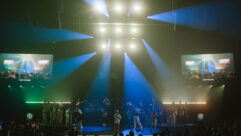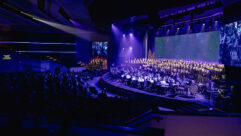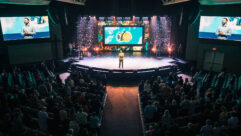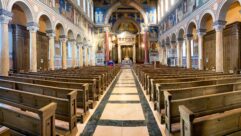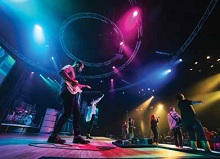

Oct 14, 2014 11:36 PM, By Joy Zaccaria
How Church Unlimitedequipped for a rock sound
After 15 years, the collection of churches in Corpus Christi, Texas, known as the Bay Area Fellowship became Church Unlimited. As they reached out to a growing youth congregation, it was not just time to change the name, it was time to upgrade the AV technology to a concert-level experience for the 8,000-plus worshippers who call it home.
David Rotter is the production manager for Church Unlimited. He handles technical production as far as lighting and sound for the broadcast campus and eight other campuses that are downlinked by satellite. “We try to create a concert environment here,” says Rotter. “That’s why we’re high-impact.

Church Unlimited’s broadcast center, Bay Area Fellowship (pictured), downlinks from its campus to the other eight campuses in the Church Unlimited congregation and serves more than 8,000 worshippers. The Rodd Field campus is the church’s newest location.
We try to reach the young church by creating that environment. We make it an attraction; they see a compelling show, hear music, and they hear God’s word through that.”
Each campus has its own full band performing its own live music. For each service, the worship ends at the exact same time at each of the campuses. From there, focus goes live to the sermon, which originates from the 1,750-seat broadcast campus (Bay Area Fellowship) and is experienced simultaneously in all eight campuses.
“We have one pastor at one location, broadcasting via satellite to all the other locations,” says Gary Cosgrove, technical director at Church Unlimited. “Each campus does have their own campus pastor to do announcements as well.” There is a through-line in terms of the musical culture among the various church locations. “We all have the same underlying core with the same DNA,” says Cosgrove. “There are some regional differences. One might like a certain style of music more than another, so we try to cater to those campuses. Overall, it’s similar with subtle differences.”
The Rodd Field campus was recently built from the ground up and is one of larger locations for Church Unlimited. Seating 700 in the worship center, it has been up and running since February. “Going 100 percent LED was our main focus for this new auditorium,” Rotter says. “We already have a relationship with Martin Professional, that’s mainly why we went with their product. For us, it was good timing that the Rush series was released right at the time we were looking for lighting.”

The broadcast campus uses JBL VerTec line arrays and a Soundcraft console and influenced the installation at the Rodd Field campus. To keep things simple for its volunteers at the Rodd Field campus, JBL VRX series loudspeakers and another Soundcraft console were installed.
Rotter went with Martin’s Rush fixtures, the MH1 Profile, along with the Martin Mac 101 cube. The church is using the Mac 101 CTs for front lighting and Mac 101 RGBs for lighting on the band. “We’re 100 percent LED for everything in the room,” Rotter says. “And we are making that transition as we build more campuses and retrofit some of our other campuses. We really like the Rush MH1 Profiles.”
The choice for sound reinforcement at the new campus was driven by the existing equipment the church uses in the broadcast campus. “We decided to stay within the same product line,” Cosgrove says. “That helped with volunteer training since it is similar to the equipment that they learned on. In addition, we were very happy with the reliability of the equipment.”
At the broadcast campus, the church has been using JBL VerTec line arrays and a Soundcraft console. “We have a good relationship with Harman products,” Rotter says. The team wanted to maintain that same footprint they had at the broadcast campus at the Rodd Field campus, so they went with the JBL VRX series for the new building.
The overall goal for the lighting and audio installation is that the worship is high-energy, high-impact. “Product decisions were based upon what was proven to work in the secular world,” Cosgrove says. “And also based on what local support we could get, reliability of equipment, and support of manufacturer if we had a problem.
The timeframe for the installation at the Rodd Field campus was about six months from the planning stages to installed and working system. “All planning and floor plans were done ourselves inhouse,” Rotter says. The Church Unlimited team avoided some challenges by taking proactive measures to seek JBL’s guidance during the planning process. “We involved JBL in the spec of the system,” Cosgrove says. “Once we had the floor plan and room design done, we realized we had some unique issues in that we had a concrete floor and completely removable seating.” JBL personnel helped with the control of the sound by way of design and sound deadening techniques. “It was a livelier room in terms of reverb, compared with other rooms we’ve dealt with,” Cosgrove says. JBL suggested solutions such as choosing the correct wall panels and the most effective decisions based on seating materials and pads for chairs.”
Over the course of the installation, the plans for the lighting evolved since the Martin fixtures were more efficient than originally planned for. They decided to lose some fixtures that were originally spec’ed. “The issue we had with LED lights was that we had more light than we expected when we started spec’ing the system,” Rotter says. “It turned out we could achieve the same effect with fewer fixtures, and we didn’t have to run them as brightly.”
Church Concert
Oct 14, 2014 11:36 PM, By Joy Zaccaria
How Church Unlimitedequipped for a rock sound

Volunteers run all the light, video, and audio equipment at all the Church Unlimited locations, with training done at the new Rodd Field campus. With so many campuses, five to 10 volunteers are trained monthly.
Coordinating a live show and a broadcast at the same time, there are some logistics to take into consideration. The projection screen must be lowered and the lighting controlled so as to be out of frame. “Where the band is, a large screen comes down in that space once the sermon starts,” Cosgove says. “The lighting does change at that point and is specifically located to allow for the screen to go up and down, and for the projection of the sermon at that point.” That was one of the reasons they chose to go with the Martin. “We chose the Mac 101 CT for that front light because we can use it as wash light and we can move it so we don’t need as many fixtures,” Rotter says. The crew is able to use the light for multiple purposes because of the nature of its design, which is something new to them. “Normally, we would have had multiple fixtures to do the same thing,” Cosgrove says.
For projectors, Church Unlimited is predominantly a Panasonic house. “We like the quality and the pricing,” Cosgrove says. “As a church, we’re always trying to get the best picture at the best price.” Using Sony video cameras, the church runs full HD through the campuses via the satellite. A Broadcast Pix video switcher rounds out the general infrastructure of the video.
“When it comes to choices of equipment, from speakers on back to the sound boards and lights going back to the lighting control, we try to focus on simplicity in terms of how things operate because volunteers are running everything, including the new Rodd Field campus,” Cosgrove says. “Ease of operation was a big part of why we chose the Mac CT, and all our lighting; and one of the reasons we went with the Soundcraft console for audio.” If there is a problem, or a volunteer can’t figure out how to do something, Rotter and Cosgrove have an easier job of trouble-shooting over the phone because of the equipment they chose.
In the past, the lighting software would pose a special problem. “There would be different lighting software at each of the campuses, and it was hard for the staff to troubleshoot if they had a problem,” Cosgrove says. “Now we can literally log in to their computer and operate their gear.”
Volunteers run the equipment at all of the Church Unlimited locations. All the training is now done at the new facility at the Rodd Field campus. Since there are so many campuses, five to 10 volunteers are trained in lighting and audio every two to four weeks. Feedback from the volunteers has been positive because the Church Unlimited team made it easy for them to step in on the weekends and operate the system. “It’s easy and comfortable for volunteers to run,” Cosgrove says. “They are not intimidated, but they are excited to come in and operate the equipment.”
Volunteer Training Resources
Several major manufacturers offer a variety of in-person—as well as online—training resources for houses that have chosen or are considering their gear.
Perhaps best-known among those resources is the Worship Arts Technology Summit or WATS (gotowats.com), an organization co-sponsored by Yamaha, Yamaha Commercial Audio, and Shure, together with Renewed Vision, Elation Professional, and Elite Core. WATS produces one-day bootcamps and two-day training events around the country throughout the year. The final event scheduled for this year is this month, on Oct. 17-18 at Oak Hills Church in San Antonio.
WATS offers five parallel tracks—for musicians, media, audio, lighting, and vocals—covering both the art and science of the technology, with some cross-discipline training. The syllabus is intended for both professionals and volunteers and is structured to accommodate the entire church team at all skill levels, enabling participants to advance as they build on their knowledge.
Separately from its involvement with WATS, Yamaha’s educational initiatives encompass training on the operation of the brand’s digital audio consoles; tuition on Yamaha Sound System Simulator (YS3) software for Yamaha Installation Series speakers; instruction on NS-1, Nexo’s Windows- based sound system design tool; and a one-day course on designing, configuring, operating, and troubleshooting Dante-based digital audio networks. These initiatives take place under the YCAT (Yamaha Course Audio Training) umbrella.
Upcoming three-day training covering Dante and Level 1 and Level 2 console operation on consecutive days are scheduled for Nov. 11-13 in Wakefield, Mass., Nov. 18-20 in Montreal and Dec. 9-11 at the company’s Buena Park, Calif. headquarters. Yamaha additionally maintains a Console Lab where operators can practice mixing for up to two hours per day free of charge. Training event details and dates can be found on the company’s website at yamahacommercialaudiosystems.com.
Harman also offers a program, Mixing with Professionals, for its Soundcraft mixing consoles, which are popular in HOW applications. The events are intended for anyone wishing to learn more about the brand’s digital desks or for those making the transition from analog to digital consoles. In the past, the company has presented about 45 Mixing with Professionals events per year. Future training dates can be found on the company’s website (soundcraft.com). –Steve Harvey


